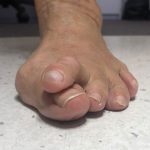 A toe which has the middle joint permanently bent downwards.
A toe which has the middle joint permanently bent downwards.
A condition in which a toe becomes deformed in such a way that it bends downward or becomes clenched like a claw. It is painful and causes a reduction in the person’s ability to move the toe, sometimes making it uncomfortable and difficult to walk and almost impossible to jog or participate in sports. It may be caused by poorly fitting shoes or by muscle and nerve damage as a result of diabetes mellitus. In some cases, corrective surgery is necessary.
A deformity of a toe, most often the second, caused by fixed flexion of the first joint. A com often forms over the deformity, which may be painful. If severe pain does not respond to strapping or corrective footwear, it may be necessary to perform arthrodesis at the affected joint.
The deformity in which there is permanent flexion, or bending, of the middle joint of the toe. The condition may affect all the toes, as in claw-foot; more commonly it affects one toe, usually the second. It is due to a relatively long toe and the pressure upon it of the footwear. A painful bunion usually develops on the affected toe. In mild cases, relief is obtained by protecting the toe with adhesive pads. If this does not suffice, then surgery is necessary.
Condition in which one or more toes (most commonly the second toe) is permanently flexed, giving a clawlike appearance.
A toe posture characterized by hyperextension of the metatarsophalangeal and distal interphalangeal joints and flexion of the proximal interphalangeal joint.
Hammer toe is a toe deformity, typically of the second toe, where one of the joints stays bent due to an abnormality in the tendon. This condition often leads to a painful corn forming on the affected joint. A protective pad can alleviate pressure on the joint and provide pain relief. However, if the pain continues, surgical intervention might be required.
A bend in the toe’s closest joint to the foot occurs when the soft tissues contract, preventing the toe from straightening. This condition is often caused by poorly fitting shoes that don’t allow the toe to lie flat, making it more prevalent among women. In some cases, multiple family members may have the condition. Surgical intervention is the treatment option if the toe causes severe pain. This condition is also known as mallet toe.
